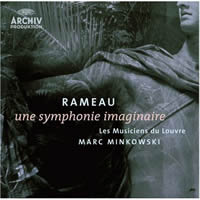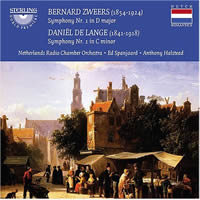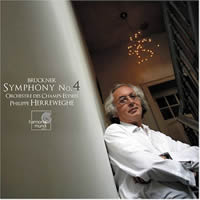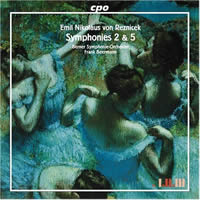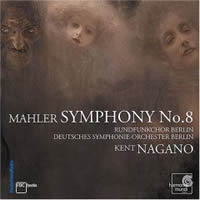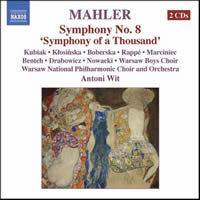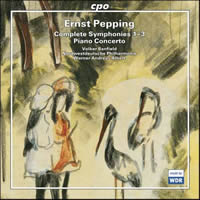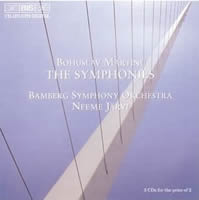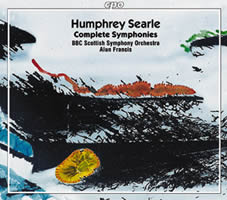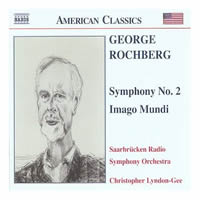Mostly Symphonies 3.
|
Grant Chu Covell [July 2006.]
“Une Symphonie Imaginaire.” Jean-Philippe RAMEAU: Var. movements selected and ordered by Marc Minkowski. Les Musiciens du Louvre, Marc Minkowski (cond.). Archiv B0004478-02 (http://www.deutschegrammophon.com/). “…[W]e still sorely missed the symphonie that Rameau never wrote. And so we created it ourselves.” So explains Minkowski for this 17-track assemblage of orchestral music snipped from Rameau’s operas and ballets (Zaïs, Castor et Pollux, Les Fêtes d’Hébé, Dardanus, Le Temple de la Gloire, Les Boréades, La Naissance d’Osiris, Platée, Hippolyte & Aricie, Naïs and Les Indes galantes plus a transcription from the Pièces de Clavecin). Vocal lines were sometimes pruned to let the orchestra shine. Les Musiciens du Louvre are earnest, perhaps too aggressive, with the evenly balanced recording skirting the claustrophobic. The authentic-instrument band plays like bold rockers, shaking up the Ouverture to Zaïs and delivering the familiar Musette and Tambourin from Les Fêtes d’Hébé with exceptional force. Comparing the pumped-up Tambourins I & II from Dardanus with the complete opera (Archiv 463 476-2) reveals Minkowski and the band aiming for the jugular. Rameau’s genially modern harmonie combined with rustic percussion, the twang of open gut strings and prominent bassoons chugging at bass-lines reminds the listener of over-powdered British film scores of a certain age: Nyman, of course, and Geoffrey Burgon’s music for the cult Brideshead Revisited. You could argue that these numbers work best in context, and that had Rameau experimented with the nascent symphonic form he would have done something completely different. The beauteous Scène funèbre from Castor et Pollux and the Entrée de Polymnie from Les Boréades seem too dramatic to be symphonic. As a ragtag excerpt collection, this disc is first-rate; I’ve been listening to it almost daily since I first came upon it. In its frisky way, one of the year’s best.
Bernard ZWEERS: Symphony No. 1 in D Major (1881); Daniël DE LANGE: Symphony No. 1 in C Minor, Op. 4 (1868). Netherlands Radio Chamber Orchestra, Ed Spanjaard, Anthony Halstead (conds.). Sterling CDS 1068-2 (http://www.sterlingcd.com/). Distributed in the US by Qualiton (http://www.qualiton.com/). Dusting off forgotten symphonies, Sterling releases two noteworthy No.1s. A sunny, amiable effort, Zweers’ 26:18 First fills textbook forms with modest invention and color. The introductory wind paragraph — fluently played by the Netherlands Radio Chamber Orchestra — discloses tantalizing promises well met. Grand passages in the Adagio and Finale suggest national anthems, though Beethoven’s Second and Fourth are not far behind. In his First’s opening, De Lange, trying for Wagnerian weight, comes closer to Grieg. The carefree scherzo recalls Schubert. The Zweers was taped in 1994, the De Lange in 2001. Both clean recordings feature the lively Netherlands Radio Chamber Orchestra, a joy to hear. It surprises to hear Spanjaard with tonal repertoire (he does superbly); he’s more familiar for his work with the Ensemble Intercontemporain and the Nieuw Ensemble (see him conduct Boulez’s Éclat on Idéale Audience DVD9DS15). Similarly, Halstead is known for his work in earlier eras. Sterling has released Zweer’s Second (CDS 1061-2).
Anton BRUCKNER: Symphony No. 4, “Romantic” (1878/80). Orchestre des Champs-Élysées, Philippe Herreweghe (cond.). Harmonia Mundi HMC 901921 (http://www.harmoniamundi.com/). Piotr Ilyich TCHAIKOVSKY: Symphony No. 6, “Pathétique” (1893); Serenade for Strings (1881). Royal Philharmonic Orchestra, Daniele Gatti (cond.). Harmonia Mundi HMU 907394 (http://www.harmoniamundi.com/). I enjoyed Gatti’s wonderful Tchaikovsky Fourth (HMU 907393) and was eager to hear what he does with this great symphony. I admit to disparaging Tchaikovsky over the years, having slowly come to recognize that his Sixth is a pinnacle. (One tries to overlook the bathos of the symphony’s moniker and the composer’s death nine days after the premiere.) As to the performance, the Royal Philharmonic Orchestra performs drowsily until the middle of the march. The 5/4 waltz should swoon more. Both the opening and closing movements are noncommittal, the last movement’s usually crushing retreat unsatisfactorily hurried. Filling the disc with the ubiquitous Serenade for Strings, the Royal’s businesslike approach cranks out a warhorse without sentimentality. The lush strings’ impatience works to fine effect. I’ll come back to this disc for the Serenade only. Similarly, having appreciated Herreweghe’s period approach to Bruckner’s Seventh, I looked forward to this “Romantic.” However, after auditioning this Fourth several times, I lost interest midway through the Andante. The orchestra plays well, especially in the scherzo, but Herreweghe, engendering nothing particularly distinctive, makes no probing discoveries. Most any Gotterdammerung-like interpretation is preferable, but perhaps that’s the point: Herreweghe doesn’t “do” Wagner which may explain why the more evolved Seventh fares better. Harmonia Mundi should jerk back the leash and insist Herreweghe stick to those periods where he’s proven he does exceptional work.
Emil Nikolaus von REZNICEK: Symphony No. 2, “Ironic” (1904/05); Symphony No. 5, “Dance Symphony” (1924/25). Berner Symphonie-Orchester, Frank Beermann (cond.). cpo 777 056-2 (http://www.cpo.de/). Distributed in the US by Naxos (http://www.naxos.com/). I had not heard Reznicek’s chestnut, the Donna Diana Overture, until a set of overtures came my way (DG 469 322). Reznicek hardly challenges, but his Second Symphony could be paired with Prokofiev’s Classical, as both view the past through rose-colored glasses. Reznicek inhaled the same crumbling-empire air as his contemporary Richard Strauss, but while Don Juan’s creator grew grandiose, Reznicek moved towards a Hadyn-sized orchestra. The “Ironic” tag didn’t originate with the composer, who, however, never objected. In four movements, directionless harmony thwarts heroism. Warm melodies suggest slushy Schubert and Mahler. Nielsen’s Sixth has a winsome conspirator in these wonderful 25 sugar-coated minutes. The later Fifth sequences a polonaise, csárdás, ländler and tarantella, purely superficial fluff.
Gustav MAHLER: Symphony No. 8, “Symphony of a Thousand” (1906-7). Sylvia Greenberg, Lynne Dawson, Sally Matthews (sop.), Sophie Koch, Elena Manistina (alt.), Robert Gambill (ten.), Detlef Roth (bar.), Jan-Hendrik Rootering (bass), Rundfunkchor Berlin, MDR Rundfunkchor Leipzig, Windsbacher Knabenchor, Deutsches Symphonie-Orchester Berlin, Kent Nagano (cond.). Harmonia Mundi HMC 901858.59 (http://www.harmoniamundi.com/). Gustav MAHLER: Symphony No. 8, “Symphony of a Thousand” (1906-7). Barbara Kubiak, Izabela Klosinska, Marta Boberska (sop.), Jadwiga Rappé, Ewa Marciniec (alt.), Timothy Bentch (ten.), Wojtek Drabowicz (bar.), Piotr Nowacki (bass), Warsaw National Philharmonic Choir and Orchestra, Polish Radio Choir in Kraków, Cardinal Stefan Wyszynski University Choir, Warsaw Boys Choir, Antoni Wit (cond.). Naxos 8.550533-34 (http://www.naxos.com/). Mahler’s Eighth can bewilder. Upbeat compared to its mature brethren, it swims among universal themes. The Veni, creator spiritus’ smooth counterpoint and the atmospheric stage-setting for the final scene of Goethe’s Faust are quite unlike anything else in Mahler’s output. Certainly it’s a high-Romantic acme. Other armchair listeners have praised Nagano’s sonics, which sound to me overblown. Impressive, yes, and yet the music remains remote. Balancing soloists, choirs, organ and orchestra (including mandolin and piano) isn’t easy, especially when the Eighth’s grandiosity defaults to a marshmallow consistency. Wit’s sonics are less blustery and better balanced. He reveals string runs, brass gestures and inner voices I hadn’t heard so clearly before. The soloists are perhaps the weakest link: mature and accurate yet somewhat unsteady in their diction. I expect magic in the connecting bits, the Allegro, etwas hastig between Veni, creator spiritus’ two Infirma nostri corporis sections, Part II’s start, and at Blicket auf! Nagano’s Infirma nostri corporis progresses too sluggishly. Nagano’s tempos amble deliberately, offering unexpected opportunities to revel in Mahler’s sound. Wit’s team provides goose-bump enchantments. Wit’s Accende lumen sensibus sounds like a fugue, Nagano’s is merely busy. The closing Alles Vergängliche ist nur ein Gleichnis sounds heavenly in Wit, ponderous in Nagano. Hands down, Wit’s Mahler is excellent. Naxos’ release lacks texts, Harmonia Mundi contains an elegant booklet, and both have Klimt-loving art directors. Mahler: Symphony No. 8 (1906-7)
Ernst PEPPING: Symphony No. 1 (1939); Symphony No. 2 (1942); Symphony No. 3, “Die Tageszeiten” (1944); Piano Concerto (1950). Volker Banfield (piano), Nordwestdeutsche Philharmonie, Werner Andreas Albert (cond.). cpo 777 041-2 (http://www.cpo.de/). Distributed in the US by Naxos (http://www.naxos.com/). Does it matter how Pepping occupied his time during the Third Reich? Cpo’s notes say little other than that during postwar rehabilitation the composer felt passed over. Completed in 1944, the Third waited for its premiere until 1948. Remembered as a composer of choral music, Pepping’s undemanding symphonies reveal scant awareness of their times. Except for a touch of neoclassicism, they seem naïvely indifferent. Strauss and Korngold were far more adventuresome. Increasingly irrelevant to music’s postwar trends, Pepping, who died in 1981, stopped composing in 1968. Delightfully harmless and plumped with pleasant themes, the neatly constructed First bathes in easy tonality, a cloudless, four-movement concert overture. Some may find Pepping’s perpetual sunshine an irritant. The Second’s contrasting severity feels unwarranted. The rambling first movement contrasts several themes, finding no catharsis. Sufficiently constructed, Pepping’s quickly tumbling orchestral transparency suggests late Mahler attempting film scoring. The scherzo is truly strange: a sterilized Weill or Hindemith joins the circus. The 1944 Third sounds as if it was written in the century’s first decade. Cpo could have mislabeled the symphonies, with no one other than the odd musicologist being the wiser. Bits in the second movement recall Weimar Berlin, with a little tune suggesting a particular anthem. The third movement’s odd harmonization and abrupt mood shifts hint at Ives. The subtitle, “Times of the Day,” apparently has nothing to do with Pepping’s wartime routine. The anachronistic, mildly neoclassical Piano Concerto’s jazz inflections sound like a vacuous tourist’s postcard. On the whole, finely performed and strange enough to play for friends.
Bohuslav MARTINU: Symphony No. 1 (1942); Symphony No. 2 (1943); Symphony No. 3 (1944); Symphony No. 4 (1945); Symphony No. 5 (1946); Symphony No. 6, “Fantaisies symphoniques” (1951-53). Bamberger Symphoniker, Neeme Järvi (cond.). BIS CD 1371/72 (http://www.bis.se/). Distributed in the US by Qualition (http://www.qualiton.com/). Martinu’s symphonies deserve revival. Unfortunately this collection disappoints in every way. The pedestrian readings lack insight. Neither dissonant nor difficult, the composer might seem undeserving of exploration, and yet within his distinctive harmonic and melodic style he cuts a wider path than most. Supraphon’s old set (rec. 1976-78, 11 0382-2), with the Czech Philharmonic and Vaclav Neumann’s native flair, bests Järvi and the Germans. Another modern cycle, Bryden Thomson’s with the Royal Scottish National Orchestra, frequently misses Martinu’s elegance (Chandos CHAN 9103-5). To judge from his sensitively shaped Fifth (EMI 7243 5 75091 2 1) recorded 1971 with the Toronto Symphony Orchestra, what would most please is a collected set of Karel Ancerl’s Martinu readings.
Humphrey SEARLE: Night Music, Op. 2 (1943); Overture to a Drama, Op. 17 (1949); Symphony No. 1, Op. 23 (1952-53); Symphony No. 2, Op. 33 (1956/58); Symphony No. 3, Op. 36 (1959/60); Symphony No. 4, Op. 38 (1962); Symphony No. 5, Op. 43 (1964). BBC Scottish Symphony Orchestra, Alun Francis (cond.). cpo 777 131-2 (http://www.cpo.de/). Distributed in the US by Naxos (http://www.naxos.com/). Cpo reassembles Francis’ 1995, ’97 and ’98 Searle symphony recordings as a double set. Illustrating serialism’s potential, they develop from warm grittiness (First, Second and Third) into strident atonality (Fourth and Fifth). Never forgetting his studies with Webern, Searle dedicated Night Music and the Fifth to his Austrian teacher. Francis guides the BBC Scottish Symphony Orchestra unhesitatingly through formidable music, discounting those moments when an unlucky combination of pauses, tricky string writing and a dry acoustic conspire to portray Searle as threadbare. British serialists constitute a small set. Whereas Searle absorbed Webern’s concision, Gerhard’s symphonies, closer to Schoenberg, are rather more bruising. The four-movement First fidgets restlessly with its fluent serialism. For the most part, Searle’s symphonies are monothematic, a single line strongly supported with plain counterpoint. The First’s final movement features two false endings. Darkly expressionistic, the three-movement Second propels towards a martial conclusion. Also in three movements, the Third, with its shorter motives, is plainly meaner. A central movement, with its brass fanfare recalling Wozzeck, builds crisply. The sprightly Fourth demonstrates how dodecaphony’s intrinsic pitch turnover can yield brief gestures. A cimbalom appears in the last two movements. The multi-part Fifth flows without a break. Still sharply angular, Searle finds great variation though continually changing orchestration and rhythm. At just under nine minutes, the atmospheric Night Music discloses a varied orchestration across variations. While Searle seems not to have had a specific drama in mind, the Overture to a Drama’s salted atonality suggests tragedy.
George ROCHBERG: Symphony No. 2 (1955-56); Imago Mundi (1973). Saarbrücken Radio Symphony Orchestra, Christopher Lyndon-Gee (cond.). Naxos 8.559182 (http://www.naxos.com/). Representing two apparently contradictory aesthetics, this disc may surprise listeners unfamiliar with Rochberg (see here, here and here). This Second — the quintessential atonal “angry man” symphony — forges Varèse and Schoenberg into a strong alloy. The felicitous employment of 12-tone methods is readily apparent in Rochberg’s wonderfully dense harmonies, strong melodic lines and flowing counterpoint, especially in the central Adagio. Compared to the New York Philharmonic / Werner Torkanowsky recording (CRI CD 768), Lyndon-Gee takes fast movements faster and slow movements slower. The older yet fresher taping (1961?) delivers bruising punches, whereas Naxos’ 2000 recording merely glowers. While such music has become easier for present-day orchestral players, the performance’s nonchalance doesn’t suit this symphony. The eclectic Imago Mundi recreates the traditional Japanese Gagaku ensemble amid several folksy Stravinskian episodes (Petroushka and Rite are elegantly spoofed). Bizarrely the 24:06 Imago Mundi feels longer than the 31:28 Second. Rochberg’s First will be released on Naxos 8.559214.
[More Grant Chu Covell, Mostly Symphonies]
[Previous Article:
Further Aperghis Sightings]
[Next Article:
BWV 988, part one]
|
